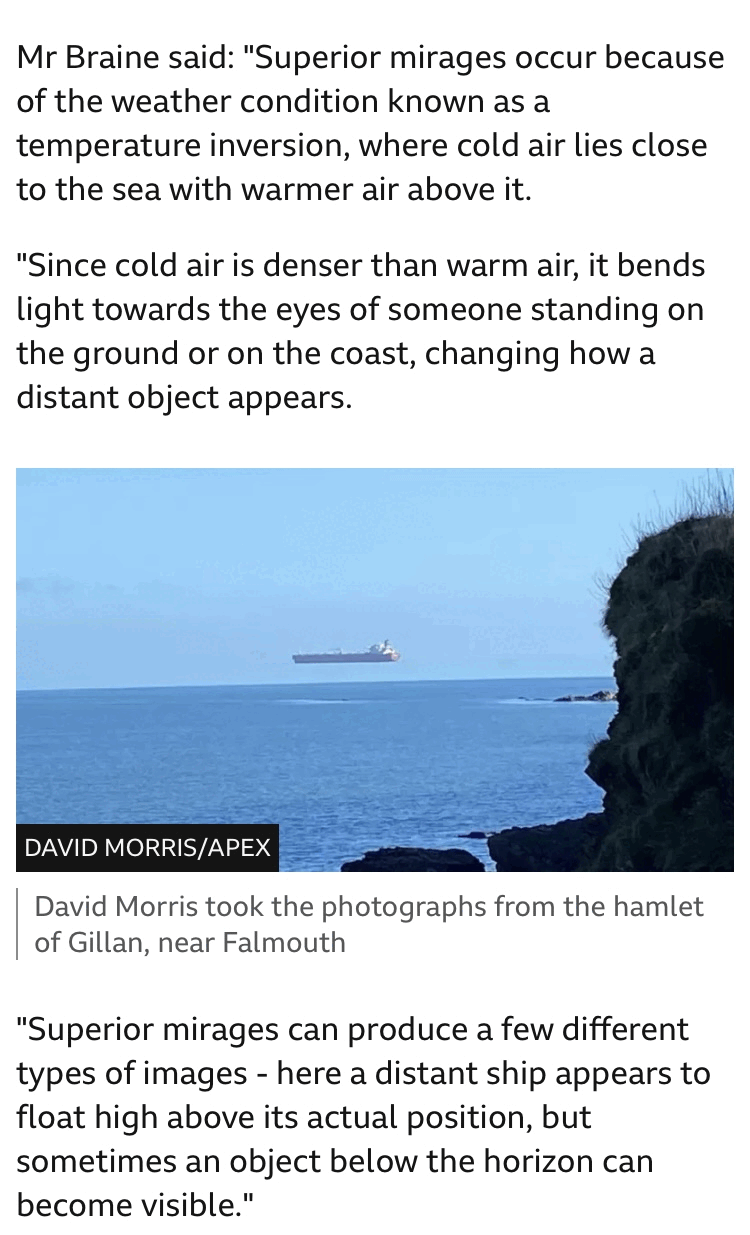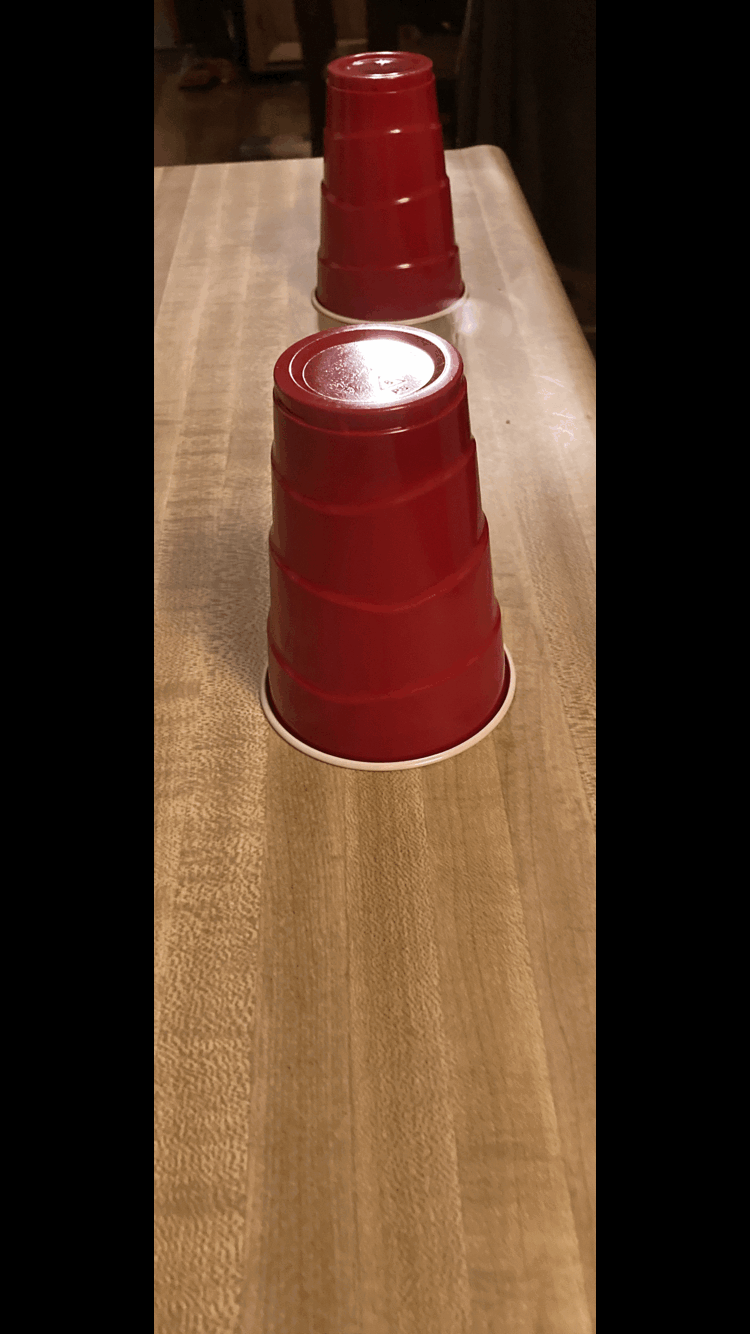It looks like you're using an Ad Blocker.
Please white-list or disable AboveTopSecret.com in your ad-blocking tool.
Thank you.
Some features of ATS will be disabled while you continue to use an ad-blocker.
share:
Double post
edit on 10-2-2023 by WhatItIs because: (no reason given)
originally posted by: cooperton
You just ignored an abundance of photographic evidence that there's no curve.
Do steel cargo boats float in midair too?

Again. Refraction is well known and understood. Like how weather affects how much of Chicago’s buildings you can see.
Why can’t you see all of the length of buildings of Chicago?

Anyway, refraction changes with weather.
Skyline Skepticism: The Lake Michigan Mirage
www.abc57.com...
To those that doubt affects of refraction. The full Chicago skyline should be visible all the time if it weren't the case, barring clouds, rain or fog. However that’s not the case, it is always changing. I encourage anyone to go look for themselves.
You
Gravitational lensing is a fundamental aspect of Einstein's relativity theory, the prevailing theory of astronomical bodies.
If the gravitational lensing of the light from the Sun
Draw out how that is using the earths’s horizon to physically block the view of the sun only at sunset. And how it’s affecting the long distance photography.
edit on 10-2-2023 by WhatItIs because: (no reason given)
edit on 10-2-2023 by WhatItIs because: (no reason
given)
edit on 10-2-2023 by WhatItIs because: (no reason given)
originally posted by: WhatItIs
Again. Refraction is well known and understood.
Yes and it's well known and understand the extent that refraction can alter the trajectory of light on earth is about 0.1 degrees, as was said in your link. You can also double check the math here. So let's assume the most extreme refraction. You can plug the numbers in this calculator:
www.1728.org...
Let's use the record setting photograph for example. A 443km distance, viewing a 3.8km tall mountain, viewed from a 2.8km tall mountain, should be 5km of obstruction from the curve (source). Yet the 3.8km mountain is visible. Not just the top, but a majority of the mountain. Even with an additional 0.1 degree of optical refraction, it would only grant an extra 0.7km of vision. This means the mountain should not be visible on a curved earth even with optimal refraction.
originally posted by: WhatItIs
a reply to: cooperton
Shrugs…
Your own links just proved its beyond the possibility of being refraction. You can't just shrug that off
Why isn’t whole buildings of the Chicago skyline visible at 55 miles?
Why would they be blocked at all on a flat earth.
One at a time. Back to the long distance photography. If you can't prove a curve with empirical mathematics then you're compelled to concede
originally posted by: cooperton
Your own links just proved its beyond the possibility of being refraction. You can't just shrug that off
Cite and quote which links…
You
One at a time. Back to the long distance photography. If you can't prove a curve with empirical mathematics then you're compelled to concede
Not going to jump through loops if you can’t explain why the bottom of the buildings are not visible at just 55 miles…

edit on 10-2-2023 by WhatItIs because: (no reason given)
edit on 10-2-2023 by WhatItIs because: (no
reason given)
originally posted by: WhatItIs
Cite and quote which links…
tchester.org...
Maximum 15% extra visibility with extreme refraction. The world record photograph would have to be exhibiting about 20% just for the tip top to be visible. But even more than the top is visible. It is beyond being explained away by refraction
originally posted by: WhatItIs
Not going to jump through loops if you can’t explain why the bottom of the buildings are not visible at just 55 miles…
Waves in the midst of Lake Michigan range from 1-2 meters tall. Therefore we subtract 2 meters of eye height from the curve calculator and see that it would actually add about 70 meters of obstruction.
dizzib.github.io...
This is approximately what is exhibited in those photos taken from the shore
It's flat.
edit on 10-2-2023 by cooperton because: (no reason given)
originally posted by: cooperton
Waves in the midst of Lake Michigan range from 1-2 meters tall.
Ok. While stories / floors of the buildings are missing. Lengths easily 10 to 20 foot.
And the waves would have a lot less effect on what is blocked with a picture taken from higher ground.
originally posted by: WhatItIs
Ok. While stories / floors of the buildings are missing. Lengths easily 10 to 20 foot.
70 meters of obstruction is 210ft. That's about what is exhibited in the skyline
And the waves would have a lot less effect on what is blocked with a picture taken from higher ground.
That picture is taken from the shore.
originally posted by: cooperton
tchester.org...
Quote which one of my posts used this link
You posted this..
originally posted by: cooperton
Yes and it's well known and understand the extent that refraction can alter the trajectory of light on earth is about 0.1 degrees, as was said in your link.
Cite and link to which one of my “links” made this claim. I want to read the context.
edit on 10-2-2023 by WhatItIs because: (no reason
given)
originally posted by: cooperton
That picture is taken from the shore.
This photo?
That evening at the top of Warren Dunes, it was pretty exciting as the inversion was setting-up. It was a spring night, the lake waters were very cold and it even felt warmer on top of Tower Hill than on the shore. Looking out on the horizon, a dark line started to show-up just above it, that was the inversion. We could see the atmospheric “lensing” or refraction happening. Objects would appear and disappear, there were breaks in buildings or they’d appear upside down depending on how the atmospheric conditions were changing.
“It's been amazing to watch how it changes. The cloud cover changed and then amount of light coming through made a big difference in the visibility of the city,” said Nowicki.
“What’s happening is the light from Chicago is being bent by the cold air above lake Michigan, slightly downward towards the observer here. That’s helping light rays get around the curvature of the earth, so that Chicago can be seen almost all the way down to ground level,” Dr. Rennie said.
www.abc57.com...
Shore. Top of Warren Dunes. Whats’s a flat earth lie or two.
edit on 10-2-2023 by WhatItIs because: (no reason given)
originally posted by: WhatItIs
Shore. Top of Warren Dunes. Whats’s a flat earth lie or two.
The news station that reported it said it was the shore in the headline. Regardless, even if they're observing at an elevation of 60ft or so the waves will still have an impact of about 30ft of obstruction. Which explains why the bottom floors of the buildings are missing from sight
edit on
10-2-2023 by cooperton because: (no reason given)
originally posted by: cooperton
originally posted by: WhatItIs
Shore. Top of Warren Dunes. Whats’s a flat earth lie or two.
The news station that reported it said it was the shore in the headline. Regardless, even if they're observing at an elevation of 60ft or so the waves will still have an impact of about 30ft of obstruction. Which explains why the bottom floors of the buildings are missing from sight
There’s 30 foot waves in this picture from April 28, 2015.

Hell no.
And if you’re looking down from above, the waves aren’t going to obstruct crap.
Added. Especially with downtown Chicago being high enough to keep being swamped by most storm surges off the lake.

edit on 10-2-2023 by WhatItIs because: (no reason given)
edit on 10-2-2023 by WhatItIs because: (no reason given)
a reply to: WhatItIs
The point is, You shouldn't be able to see that much of Chicago across lake Michigan. Even with optimal refraction. The people at the news station went and tested it themselves and saw the same image. It's not phenomenal refraction, it's just the way it is.
As with the other long distance photography.. this is the norm. No miraculous refraction required.
The point is, You shouldn't be able to see that much of Chicago across lake Michigan. Even with optimal refraction. The people at the news station went and tested it themselves and saw the same image. It's not phenomenal refraction, it's just the way it is.
As with the other long distance photography.. this is the norm. No miraculous refraction required.
edit on 10-2-2023 by cooperton because: (no
reason given)
edit on 10-2-2023 by cooperton because: (no reason given)
I was the one who posted that source, not WhatItIs, which I guess you eventually figured out, but you are still misrepresenting the source and not fully reading the material there.
originally posted by: cooperton
originally posted by: WhatItIs
Again. Refraction is well known and understood.
Yes and it's well known and understand the extent that refraction can alter the trajectory of light on earth is about 0.1 degrees, as was said in your link. You can also double check the math here. So let's assume the most extreme refraction. You can plug the numbers in this calculator:
www.1728.org...
Let's use the record setting photograph for example. A 443km distance, viewing a 3.8km tall mountain, viewed from a 2.8km tall mountain, should be 5km of obstruction from the curve (source). Yet the 3.8km mountain is visible. Not just the top, but a majority of the mountain. Even with an additional 0.1 degree of optical refraction, it would only grant an extra 0.7km of vision. This means the mountain should not be visible on a curved earth even with optimal refraction.
If I say "typically people take longer than 5 minutes to run a mile" that is true, because most people cannot run a mile in less than 5 minutes. But you seem to want to misinterpret that "typically" to mean that nobody can ever run a mile in less than 5 minutes, and that's not what "typically" means. It's not a limit, you can find exceptions. Same with the 0.1 degrees refraction, where the source says this:
That doesn't mean you can never ever find exceptions to the 0.1 degrees, in the same way saying people typically take over 5 minutes to run a mile doesn't mean you can't find exceptions to that.
...typically only increases the observed elevation angle by less than 0.1°.
The source also says the more atmosphere the light passes through the more refraction can be experienced, and you pick an atypical case, a record setting photograph at a distance of 443 km so the record setting photo itself is not a typical case.
Clearly refraction must depend on some power of the distance. If you are observing something close by, light can't get to you any quicker by travelling very far upward. However, if you are far away from an object, light can take advantage of the faster speed at higher elevation and deviate more significantly from a straight line.
So how much more refraction can occor when the light passes through more atmosphere? The same tchester.org site mentions that refraction from the sun can be up to 0.5 degrees because sunlight passes through more atmosphere, and in fact the sun can be seen when its true position is below the horizon for that reason:
tchester.org...
So forget the idea 0.1 degrees for refraction is some kind of maximum, it's not. "typical" does not mean "maximum" and you are using an atypical example, a record-setting photograph at a distance of 443km.
Atmospheric refraction makes the elevation angles of distant peaks slightly larger. This is the same effect that causes the sun or stars to actually appear 0.5° above the horizon when they in actuality have just set below the horizon. This effect causes daylight to be ~4 minutes longer at most latitudes than it would be if the Earth did not have an atmosphere.
new topics
-
Joe Rogan conspiracy (maybe)
ATS Skunk Works: 31 minutes ago -
Results of the use of the Oreshnik missile system in Dnepropetrovsk
World War Three: 2 hours ago -
Nigel Farage now the Most Favoured UK Politician
Regional Politics: 4 hours ago -
Little Johnny and Larry should team up
General Chit Chat: 10 hours ago -
Will Us use alien technology to fight in ww3?
World War Three: 11 hours ago
top topics
-
Results of the use of the Oreshnik missile system in Dnepropetrovsk
World War Three: 2 hours ago, 10 flags -
Little Johnny and Larry should team up
General Chit Chat: 10 hours ago, 8 flags -
Shane Gillis commercial
Jokes, Puns, & Pranks: 17 hours ago, 4 flags -
Will Us use alien technology to fight in ww3?
World War Three: 11 hours ago, 2 flags -
Nigel Farage now the Most Favoured UK Politician
Regional Politics: 4 hours ago, 2 flags -
Joe Rogan conspiracy (maybe)
ATS Skunk Works: 31 minutes ago, 0 flags
active topics
-
Results of the use of the Oreshnik missile system in Dnepropetrovsk
World War Three • 71 • : Xtrozero -
President-Elect DONALD TRUMP's 2nd-Term Administration Takes Shape.
Political Ideology • 238 • : WeMustCare -
President-Elect TRUMP Picks Former Florida A.G. PAM BONDI to be U.S. Attorney General.
2024 Elections • 49 • : VariedcodeSole -
Will Us use alien technology to fight in ww3?
World War Three • 11 • : BeyondKnowledge3 -
A Mysterious Orb filmed over NYC by local news
Aliens and UFOs • 25 • : ArMaP -
The Popular Vote does not matter
Political Issues • 14 • : texas thinker -
Well we know Putins ICBMs won't fail in their silos
World War Three • 188 • : Xtrozero -
Joe Rogan conspiracy (maybe)
ATS Skunk Works • 0 • : AlroyFarms -
Shane Gillis commercial
Jokes, Puns, & Pranks • 2 • : Flyingclaydisk -
Little Johnny and Larry should team up
General Chit Chat • 2 • : texas thinker
